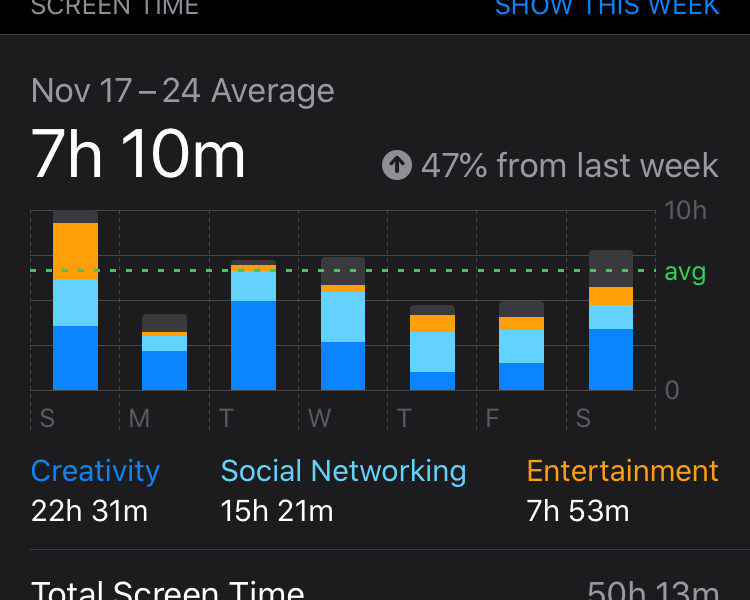By Delaney Tran and Reina Suio
Head bowed looking at their phones, the glow lighting up their faces, college-aged students who are a part of the iGen spend more time looking at screens than they do looking at anything else.
Exposure to blue light from devices with screens may damage brain cells and eyes, which can cause sleep disorders, according to a recent 2019 study done by Oregon State University. However, there are still unknown long-term effects due to how new the technology is.
“Some people don’t have computers available to them, so it makes sense that people will be on their phone, since the little device can do so much,” said Jacqueline Fuentes, a fourth-year healthcare administration major. “It’s like a tiny computer in your pocket.”
According to a 2014 report by the National Center for Biotechnology Information, college students in the United States may spend up to eight to 10 hours per day on their smartphones.
In recent years, the hours haven’t decreased due to smartphones having many features, which are replacing the use of other devices like TVs and computers.
Students in the past decade are more dependent on technology, which can interfere with social settings, according to the 2014 report. Fuentes has noticed an increasing amount of students turning to their phones, even in social situations like hanging out with friends.
Although she enjoys the advantages of having a smartphone, she values face-to-face interaction with her friends. Whenever she meets with her friends, they choose to put away their phones because it can be distracting and disengaging.
Long-term effects are currently still being researched.
Prolonged screen-time has a potential for “social isolation by being on screen-based activities instead of out in the community or out with class or their friends,” according to psychology professor Gabriella Hancock.
“It’s linked to lower perceived quality of life,” Hancock said. “Time is a limited resource, so you can spend it doing one thing or the other, so those who prioritize using screens versus those who don’t has been linked to mental health issues, but [it] has also been linked to depression and suicide in teens.”
Prolonged screen-time not only affects mental health, but it can also affect physical health. The blue light exposure from smartphone devices can cause eye strain after long-time exposure, which can lead to a disturbance in sleep patterns.
“So if you are watching TV or on a screen right up until sleep-time, you are bombarding your brain with signals that it should be awake,” Hancock said. “When you switch off the light, now your brain is getting conflicting signals, and so it takes you longer to sleep and [is] why your sleep quality is poorer.”
According to the American Migraine Foundation, long-term eye-straining can lead to migraines and vision impairment, including decreased eyesight or seeing black “spots.” For Fuentes, she said she stares at an iPad for upwards of eight hours a shift as a medical scribe. She has to lower the brightness because her eyes start to “burn” and her vision becomes blurry.
What are some solutions to reduce screen-time?
Options such as night shift on iPhones provide users with an alternative viewing mode, which adjusts the display to warmer tones. This function can decrease the amount of blue light exposure, but the function may lead to an increase in screen time and is not a solution to sleep quality and quantity, according to a study by Lighting Research Center.
Phone users are recommended to limit their screen-time to at least two hours before sleeping, so that they would not have difficulty in sleeping, according to a report made by Lighting Research Center. College students, including Larisa Simmons, a fourth-year healthcare administration major, have chosen to take melatonin pills or gummies to help them sleep.
Another way people can limit their screen-time is by using a time-limit on apps, which locks the user out after the maximum time has been reached. Social media has become a big factor in the social life of college students to network with their peers.
“I think it’s because people wanna know what’s going on, whether it’s by looking at their friends’ stories or seeing what the latest trends are,” Simmons said. “It’s addicting. People communicate primarily through those apps too, so a day without Snapchat and Instagram is like the end of the world to them.”
There is a fear of missing out on the latest trends and what their social circles are posting online. This can increase the amount of time a person is on a social media application throughout the day.
“It’s not that the people are addicted to screens, it’s not that they are addicted to TV or their phones, people are addicted to the information that those outlets give them,” Hancock said. “People are information scavengers. We love new information. […] It’s not as though they will stop using these. It’s not necessarily we want to cut them off from that information, what’s harmful is the method of delivery for that is screens.”




